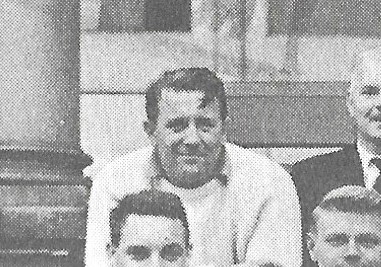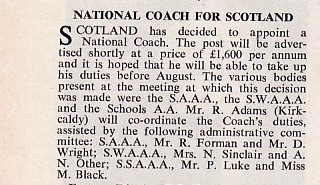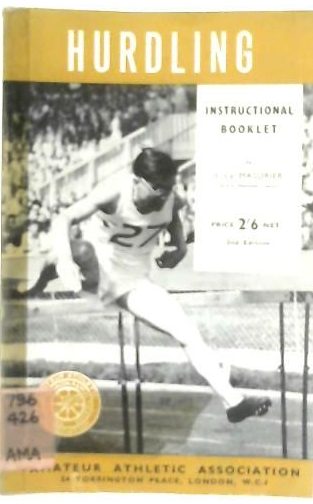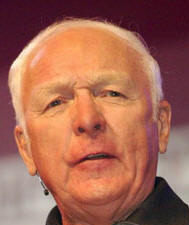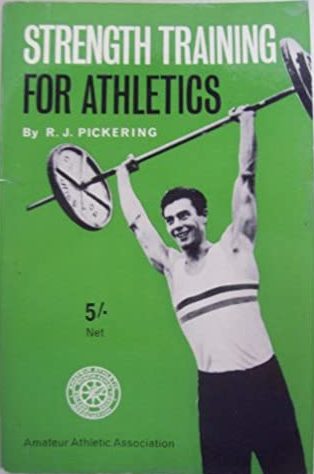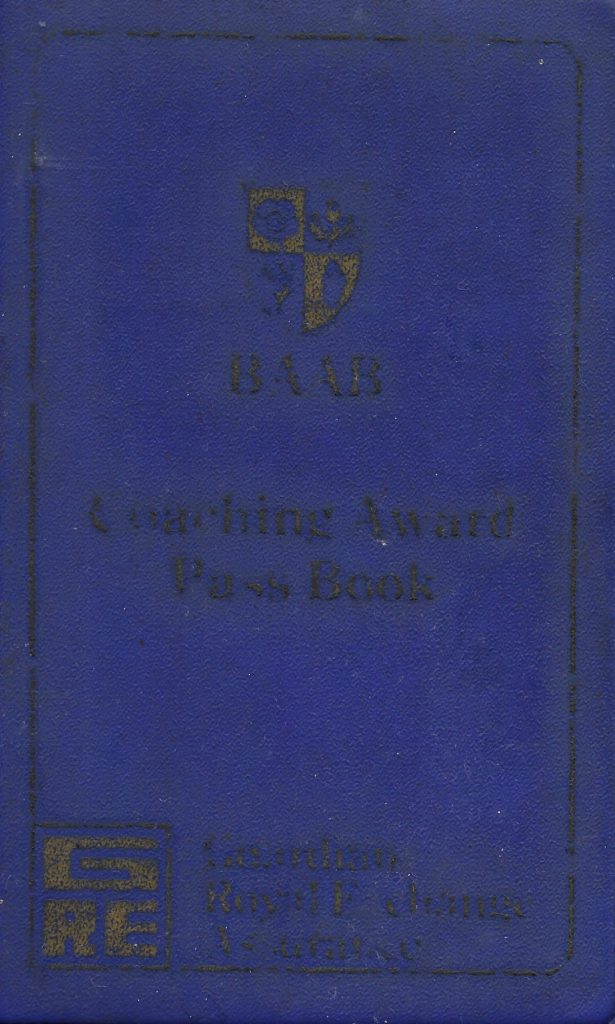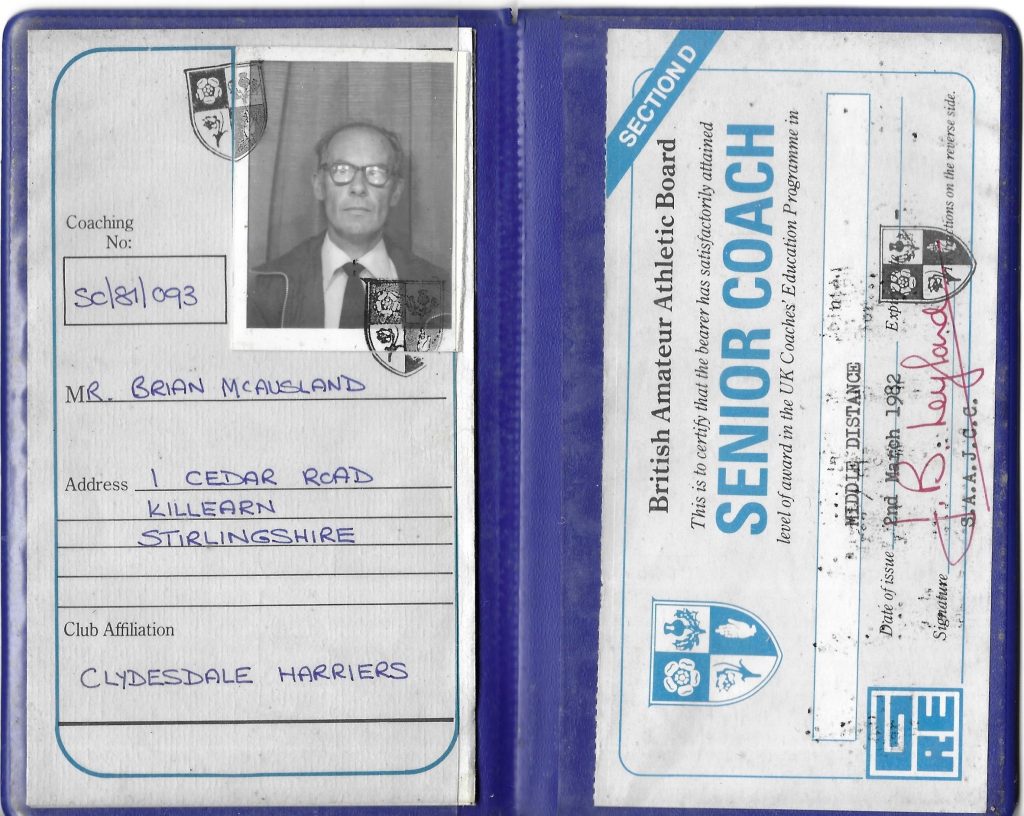When Tony Chapman (pictured above) resigned in 1961, he left behind a very good working coaching system in place. Starting with almost nothing organised, and with the help and assistance of the SAAA, there was a fairly large body of coaches ranging from very good to competent, and a programme of coach education with a cadre of lecturers, teachers and mentors. And not least there was a healthy respect for coaching and what it had to offer athletics, in contrast to some of the doubting that he himself had to face when he took up the position.
The question that the SAAA had to answer was who or what was to replace him? The SAAA had a coaching committee which appointed Bill Dickinson of the Scottish School of Physical Education at Jordanhill College in Glasgow, and RAB Foreman to act as cover for a national coach, with Bill looking after the West of the country and RAB the East. Forman had been a very good sprinter in his day and as an administrator had been President of the SAAA in 1958. Dickinson had been head of the Jordanhill Training College PE Department and would go on to be the first national coach for rugby between 1971 to 1977. These were interim, part-time appointments, probably because of the funding situation. When the new Scottish Sports Council took over from the CCPR, money would have become available for more appointments. There were by now, and partly as a result of Chapman’s work, coaches such as Jim Logan and Eddie Taylor to help look after various events. The coaching courses continued in various forms – eg the course that several of my own club mates attended in 1962 was held on ten consecutive Tuesday evenings and covered all events with the resulting qualification being for “Club Coach, All Events” . This was the format until the new Scottish Sports Council took over from the CCPR, and money became available for appointments to all NGB’s.
Then on 27th February, 1965 the following short report appeared in ‘Athletics Weekly.’.
The administrators named were all well-known and experienced in Scottish, indeed in British athletic circles. Their involvement in coaching as well as in the organisation of athletics was considerable, with Dunky Wright having been involved in the sport since he started running before the end of the first World War in 1918. The rest were not quite so long in the tooth but were as good a group as could have been found to tackle the task in hand. The key name to note from the report is that of Mr R Adams (Kirkcaldy) who would co-ordinate the coach’s activities.
Although Scottish athletics was separate from England with its own governing bodies (SAAA, SWAAA, SSAA, etc) there was a degree of overlap and co-operation between bodies on both sides of the border. The end result of the notice published in ‘Athletics Weekly’ was the appointment of John Anderson.
John had been a very active and successful coach in Scotland where, as well as working with some very talented athletes, he was responsible for the development of Maryhill LAC into one of Britain’s very best women’s clubs. At this point John was Itinerant National Coach for England, having been appointed in early 1964. He was based in the Midlands and travelled vast distances all over England filling in for other National Coaches who were unavailable for whatever reason. John was very active, very enthusiastic, very keen on developing his own store of knowledge, and one of only two coaches in Britain (Wilf Paish was the other) to have successfully completed every Senior Coach event qualification available. An amazing achievement. His knowledge of the English scene was to be very important, as SAAA and the AAA coaching had a lot in common. For instance the BAAB Coaching handbooks were excellent productions and used on both sides of the border – and further afield too. They were written by the top men in their event and kept up with the event’s progress – eg. Middle Distance Running by Tony Ward, which was updated to Jim Alford’s version and then brought further up-to-date by Martin Hyman and Bruce Tulloh; Javelin Throwing went to at least five versions; Strength Training for Athletics by Ron Pickering was a standard handbook used across several disciplines, and was superseded by Frank Dick’s version. The hurdling booklet below was produced in 1959. The actual coaching qualifications were BAAB qualifications too although they were administered and assessed by Scottish staff coaches. More about the coaching courses and qualifications later.
As National Coach in Scotland, a post he held from 1965 until 1970, John was very active, covering every aspect of the sport in every part of the country. The Scottish interest in and desire for coach education, so obvious to anyone in the sport after the War, had not gone away, and John developed a network of venues and courses for the growing interest in coach education in the country.
- He also insisted that coaching be open to both men and women and was responsible for organising women’s coaching courses at Inverclyde.
- The Scottish Schools Coaching Courses at Grangemouth were initiated by John who was the only National Coach that I knew of who even worked with Scottish Schools squad days – the Scottish Schools tend to have their own event coaches for squad days,
- He even took the coaching courses out to clubs and took athlete ‘demonstrators’, such as Cameron McNeish and Hamish Telfer with him.
- There were many different governing bodies involved in the sport in the country and John helped merge the various coaching committees into the ‘Joint Coaching Committees’. He covered huge distances and was always available.
- He was also the man responsible in the beginning for organising the Annual National Coaching Convention. This was a superb innovation, started by John and developed to a tremendous extent by Frank Dick. It brought world class coaches from all over the athletics world to speak and talk with Scottish coaches on their own turf. Every aspect of the sport was covered – technical aspects, fitness and conditioning, physiological testing – and star athletes were often present too. At the end of the conference, all the papers presented were issued to those in attendance in spiral bound booklet form for further study and for dissemination within the clubs across the land. Wherever he was, he was approachable. The coaches were all on side.
John Anderson
While the scene in Scotland was independent of the AAA’s in England, it is a small island and there was a lot of overlap, and almost all of the coaches knew and spoke with each other. John had discovered Geoff Dyson’s book ‘The Mechanics of Athletics’ soon after its publishing in 1961 and was immediately taken by it. Everything he did thereafter had to be grounded in the science of athletics, there had to be a scientific backing for what the athletes were asked to do. He also used his knowledge of and friendship with coaches from south of the Border. In England there were personnel changes – Lionel Pugh succeeded AR Malcolm, then resigned about the same time as Geoff Dyson; Jim Alford took on Wales and West of England; Ian Ward took on North-East England to lighten Dennis Watts’ work load,; then Rob Pickering took over from Jim Alford in 1961, Bill Marlow followed Pugh in the Midlands in 1962. These names were all easily recognised in Scotland at the time, because most of them came up at some time or other – eg Ian Ward spent a day at Nethercraigs in Glasgow on the pole vault and demonstrated using something most of the coaches listening had never seen – a fibreglass vaulting pole. The latest in athletics technology being shared with new coaches. In addition they were all known from their writings whether in the form of booklets or in articles in ‘Athletics Weekly, ‘World Athletics’ or even ‘World Sports’.
Then John had the sessions with athletes. For instance the lunchtime sessions at Glasgow University’s ground at Westerlands were legendary with many of the very best in the country training there. The half milers Mike McLean, Graeme Grant and Dick Hodelet were there as was Hugh Barrow from Victoria Park; distance men such as Lachie Stewart were also attendees at the lunchtime training. Runners really went out of their way to attend. Hugh Barrow says: The routine, as described by Hugh Barrow, was:
John left the post of National Coach in 1970 to become Direction of Physical Education at Heriot-Watt University. The job came up and it was a case of ‘take it or leave it.’ Always up for a new challenge, John took it on. Where was Scottish Coaching at this point of transition?
The coaching structure in Scotland was simple and straightforward – and very effective.
At the top was the National Coach who had four Group Coaches responsible to him – one each for Sprints, Endurance, Jumps and Throws.
Within each group there were Staff Coaches for individual events answerable to the Group Coach.
Sprinting had individual Staff Coaches for 100 yards, 220 yards and 440 yards plus relays
Distance running had separate staff coaches for 880/Mile, 3 Miles/6 Miles and Long Distance (including race walking)
Jumps had staff coaches for pole vault, high jump, long jump and triple jump;
Throws had separate staff coaches for Shot, Discus, Hammer and Javelin.
Each Group Coach had his own admin officer who took care of all the office work associated with the events. And of course every one of the staff coaches had his own network of trusted coaches.
The inside of the Coach’s Passbook – personal details on the left, coaching qualifications on the right
Staff Coaches had slips like the one below to go into the pocket on the right
The coaching courses were held over two weekends – the first was almost all theory and the second was largely practical sessions. The SAAA owned the Inverclyde Centre at Largs and the sessions were held there. These led to the BAAB Coaching awards and came in three categories: Assistant Club Coach, Club Coach and Senior Club Coach. It was a good system and the titles meant something. Most awards went in the Club Coach bracket which was appropriate because that was the level most coaches were operating at. The Assistant Club Coaches had to work very hard for their qualification – it was at a higher level than the current Level 1 Coach award and covered all events. It also said what it was – the coach with it realised that he was not yet at the appropriate standard to be a club coach and this was an encouragement to progress further up the ladder. There was no examination for this award, examinations came in for the first time at Club Coach standard. Senior Coach was a real test of the coach’s abilities – there were the two weekends at Inverclyde but they were specialist sessions as far as the practical work went but there was a higher standard of theory for those taking the Senior award with a three hour written paper and a practical test. In addition the Staff Coach responsible for the event was (or became) familiar with the work done on a regular basis with his athletes) The numbers operating in the country reflected this. eg as late as 1980, there were 32 Senior Coaches in the country but 103 Club Coaches. On qualification the coach was given a passbook like the one above which had two pockets inside – on the left was the coach’s personal details, on the right were the events and standard of the coaching qualification.
In addition, the coaches were listed in the SAAA annual handbook together with their addresses and telephone numbers. Why so? It was because the qualified coaches had to be available to athletes requiring their assistance. The Handbook stated at the top of the lists, before a single coach was named, that it was a list of British Amateur Athletic Board Coaches in Scotland. This statement was then amplified and qualified as follows:
The following coaches have kindly offered their services free to clubs and schools. Such coaching will be carried out locally so far as their normal occupation permits. Applications for their services should be made direct to them ( a stamped addressed envelope must be enclosed). No fee is charged for their services, but travelling expenses must be offered.”
That was pretty well the situation when John ceased to be Scottish National Coach. How successful was he? A look at some of the coaches working in the country at the time tells a story. Such men as Jimmy Campbell, Iain Robertson, Alex Naylor, Sandy Ewen, Eddie Taylor and others of similar calibre were gracing the scene. Senior Coaches were spread round the country – Edinburgh, Glasgow, Dundee, Innerleithen in the Borders, Lanarkshire, Renfrewshire, Ayrshire, Ayrshire, Fife and other centres of population. Nor were the coaches only working with distance runners – the Senior coaches covered long, triple and high jump, shot, discus, javelin and high jump, sprints, middle distance, distance and relay. John left just before the 1970 Commonwealth Games were to be held in Edinburgh and was succeeded by Frank Dick. If we compare the situation in 1980 with that when Tony Chapman was appointed in 1949, coaching in Scotland had come a very long way. There were a very few gaps – availability of pole vault coaching was virtually non-existent but it was being tackled by several coaches notably by Eddie Taylor who was Administrator of the Coaching Committee. This was a sub-committee of the SAAA General Committee and this was made up in 1980 of Bob Short as Convener, Eddie Taylor, with Brian McAusland (West District), Charles Bannerman (North of Scotland) and James Kerr (East District) as assistant administrators. Eddie was a Senior Coach for Javelin and Jumps and club coach for Sprints, Relays, MD, Shot and Discus and would become Staff Coach for what were then called multi-events. He was also representing the SAAA Coaching Committee on the Joint Coaching Committee with the SWAAA and SSAA reps completing the make-up of that body.
The sport in 1969 and into the 1970’s was in a very healthy condition as far as coaching was concerned.
